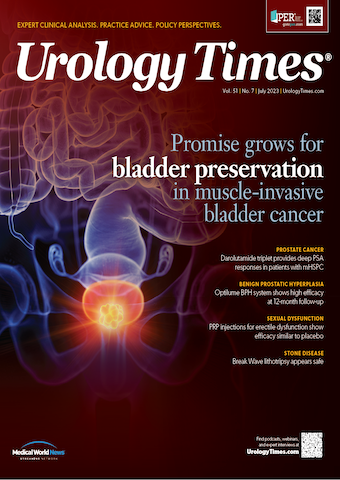Publication
Article
Urology Times Journal
Investigators assess potential trajectories of women in the urologic work force
Author(s):
Projections were made under 3 different circumstances: the rate of women entering urology continues to follow logistic growth, there is no further growth of women into urology, and retirement rates among women mirror that of men in urology.
Using demographic trends among urology residents and the current urologic work force, investigators projected the growth of women in urology and developed an app to explore a range of different growth patterns.1
The data were published in Urology.
“Our analyses indicate that there is still a significant need for targeted recruitment of female physicians into urology in order to maintain and grow female representation within the urologic work force, thus mirroring the general patient population,” said Jessica H. Hannick, MD, MSc.

“Our study sought to estimate roughly when there may be gender parity between male and female urology providers in the work force using existing recruitment, retention, and retirement trends,” explained senior author Jessica H. Hannick, MD, MSc, in correspondence with Urology Times®. Hannick is a pediatric urologist at University Hospitals and an assistant professor of urology at Case Western Reserve University School of Medicine in Cleveland, Ohio.
The investigators obtained data from the American Urological Association Censuses and the Accreditation Council for Graduate Medical Education (ACGME) Data Resource Books. Data from 2021 showed that 33.3% of urology residents were female, but only 10.9% of practicing urologists were female.
Work force projections on the growth of women in urology were made using the ‘Stock and Flow’ method. Projections were made under 3 different circumstances: the rate of women entering urology continues to follow logistic growth, there is no further growth of women into urology, and retirement rates among women mirror that of men in urology.
In the first scenario, if the number of women entering into the urologic workforce continues to grow logistically as it has from 2009 to 2021 and a 13.8% increase is seen in graduates over each 5-year period, there would be 29,107 urologists in 2062. Of these, 10,957 (38%) of urologists would be female. For comparison, the authors note that 36.3% of the overall United States physician work force was female in 2019, indicating that it would take urology 40 years to reach the current gender balance of the physician work force.
However, that growth could be slowed if the current increases falter or stagnate. In this second scenario, the percentage of female urologists would only increase to 24% in 40 years (7038 women of 29,178 total urologists).
Lastly, the authors projected the trajectory if retirement rates between men and women in urology become similar and the growth of women in urology continues to follow logistic growth. Currently, women tend to exit the urologic work force earlier than their male counterparts. In a scenario in which the retirement rates are equal, there would 29,328 urologists by 2062, with 11,178 (38%) being women.
To meet the population need for urologists by 2060, the authors indicate that 96 additional urologic training spots must become available every year. Given that trainees tend to have a greater proportion of women than the work force, increasing the number of graduates may help improve projections of women in urologic practice.
However, the authors recognized that a range of possible scenarios could occur, and thus set up an interactive app in which users can test alternate workforce parameters. Updated projections can be made when new AUA or ACGME data is released on residency positions, rate of urology graduates, and retirement rates.
Hannick concluded, “Our analyses indicate that there is still a significant need for targeted recruitment of female physicians into urology in order to maintain and grow female representation within the urologic work force, thus mirroring the general patient population.”
Reference
1. Jackson EM, Sellke N, Rhodes S, et al. How female is the future of urology? Projecting various trajectories of the United States urology workforce. Urology. Published online May 25, 2023. Accessed June 6, 2023. doi:10.1016/j.urology.2023.04.028


























